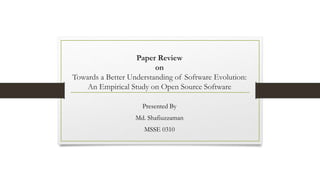Software Evolution
- 1. Paper Review on Towards a Better Understanding of Software Evolution: An Empirical Study on Open Source Software Presented By Md. Shafiuzzaman MSSE 0310
- 2. Introduction of the Paper • Authors: Guowu Xie, Jianbo Chen, Iulian Neamtiu, Department of Computer Science and Engineering, University of California, USA • Published in: IEEE International Conference on Software Maintenance • Publication Year: 2009
- 3. Area of Inquiry Software Evolution Process Verify existing laws of software evolution Analyse evolution patterns
- 4. Research Questions • Verify whether existing software evolution models are sufficient enough to characterize the software evolution process
- 5. Lehman’s Eight Laws (1970) i. Continuing Change ii. Increasing Complexity iii. Self Regulation iv. Conservation of Organizational Stability v. Conservation of Familiarity vi. Continuing Growth vii. Declining Quality viii. Feedback System
- 6. Applications • 7 open source project and 653 official releases
- 7. I - Continuing Change • A program must continually adapt to its environment, otherwise it becomes progressively less useful
- 8. II - Increasing Complexity • A program evolves, its complexity increases
- 9. III - Self Regulation • Evolution of large software systems is a self-regulating process Self Regulation: The system adjusts its size throughout its lifetime
- 10. IV - Conservation of Organizational Stability • Productive output tends to stay constant throughout a program’s life time
- 11. V - Conservation of Familiarity • Incremental system growth tends to decline source code familiarity
- 12. VI - Continuing Growth • Programs usually grow over time to accommodate pressure for change and satisfy increasing set of requirements • LOC • Number of modules • Number of definitions (types, global variables, and functions)
- 13. VII - Declining Quality • Software quality appears to be declining over time • Quality metric: defect density (defect/LOC)
- 14. VIII - Feedback System • System growth slows down over time
- 15. Observations • Laws I, II, III, and VI are confirmed • Continuing Change • Increasing Complexity • Self Regulation • Continuing Growth • ‘Conservation of Organizational Stability, Conservation of Familiarity, Declining Quality, Feedback System’ can’t be validated
- 16. Research Weaknesses and Limitations • Lack of process data for the open source projects • Limited to evolution aspects of Lehman’s laws

